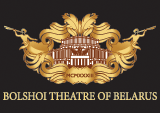 Bolshoi Theatre of Belarus
Bolshoi Theatre of Belarus
Bolshoi Theatre of Belarus
Bolshoi Theatre of Belarus
 Bolshoi Theatre of Belarus
Bolshoi Theatre of Belarus
Bolshoi Theatre of Belarus
Bolshoi Theatre of Belarus
Andrey Petrov
The Creation of the World
ballet in two acts Tuesday | 10 December 2019|19:00
Age 12+ ąöąĖčĆąĖąČąĄčĆ ŌĆō┬ĀąÆčÅč湥čüą╗ą░ą▓ ą¦ąĄčĆąĮčāčģąŠ-ąÆąŠą╗ąĖčć |
null Dates
|
Libretto, choreography and staging: People’s Artist of the USSR and Belarus, laureate of the State Prize of the Republic of Belarus Valentin Elizariev
Musical director: Honoured Art Worker of the Republic of Belarus Vladimir Moshensky
Musical director of the new version: recipient of the Francysk Skaryna Medal Vyacheslav Chernukho-Volich
Designer: People’s Artist of Ukraine, laureate of the State Prize of Ukraine Eugene Lysik
Lighting designer: Nina Ivankina
Conductors: Honoured Art Worker of the Republic of Belarus Nikolai Koliadko, recipient of the Francysk Skaryna Medal Andrei Galanov
Chorus masters of the Children’s Musical Theatre Studio: Elena Sokolovskaya, Tatyana Pyshnaya
Running time: 1 hour 45 minutes with one interval
Premiere: 11 April 1976
New version premiere: 8 December 2019
ąÉą┤ą░ą╝ ŌĆō ą×ą╗ąĄą│ ąĢčĆąŠą╝ą║ąĖąĮ
ąĢą▓ą░ ŌĆō ąøčÄą┤ą╝ąĖą╗ą░ ąźąĖčéčĆąŠą▓ą░
ąæąŠą│ ŌĆō ąĢą│ąŠčĆ ąÉąĘą░čĆą║ąĄą▓ąĖčć
ąöčīčÅą▓ąŠą╗ ŌĆō ąóą░ą║ą░č鹊賹Ė ą£ą░čćąĖčÅą╝ą░
ąöąĖčĆąĖąČąĄčĆ ŌĆō ąÆčÅč湥čüą╗ą░ą▓ ą¦ąĄčĆąĮčāčģąŠ-ąÆąŠą╗ąĖčć
“Creation of the World” – is human's handwork and a work of his mind. A human being makes good and evil in the World. And it depends on a person what will rule the World: harmony and light or chaos and dark. Composer Andrew Petrov premised these words to his score.
Together with the composer the choreographer, national artist BSSR, national artist USSR Valentine Elizariev, scenographer Eugene Lisik, conductor L. Lyah and ballet performers appeal to us, break into our existence with eternal and always anxious thoughts about the purpose of human life, about the right for happiness and service for people.
This is not a declaration, not a statement of important theses, but lively, bright, polysemantic figurative reality of the performance. The ballet responds to a crucial problem of the present – protests against threat of war, glorify the might of a human and eternal power of maternity. This significant content is realized in polyphonic interaction of musical– pictorial– choreographic themes of the ballet.
Each of the themes elaborates in aggregate of all expressive possibilities of the performance in the unity of sounding image with its plastic and scenic reality. Originality of the theme, caught up and developed in the dance by choreographer, maintains in polysemantic symbolism of the painting. Sounding of the orchestra, choreography and painting in this performance represent lively and active organic unit where the fundamental principle belongs to the music of Andrew Petrov.
The main task of the creator of the ballet was to look from viewer’s point of view at the anxiety of humanity. From here in the composition of Petrov appears a tendency to epic and civil scale, philosophic, common to all mankind general conclusion and lirycal-psychological profundity.
Thus the composer simply and wisely builds the main themes of the performance. He is unhurried, substantial, laconic. He is able to select the most essential, to consider and show the performance from different sides. Each theme-generalization bears a charge of living credibility, recognition and concrete comparisons. Thus the image of Adam, is gradually extends and being multiplied, becomes the Mankind theme, and it grows in almost symbolical generalisation of Humanity …
Authors of the Minsk performance managed to read in ballet music philosophical and poetic generalisations more considerable, than they were designated in an initial plan of the libretto. Modernity of the performance first of all is in scale of coverage of a theme, in capacity of art generalisation that gives the chance to transfer the past and even to glance in the Mankind future, keeping live communications with warmth of each human heart.
The candidate of art history E.Shumilova
The ballet program
Act I
Chaos
Paradise
Devil
God
Adam
The struggle for Adam
Eve
Act II
Childhood
Hell
Love
People
Running Time
Lamentation of Eve
Rebirth
┬½ŌĆ”ąĪąŠčéą▓ąŠčĆąĄąĮąĖąĄ ą╝ąĖčĆą░┬ĀŌĆō┬Āą┤ąĄą╗ąŠ čĆčāą║ č湥ą╗ąŠą▓ąĄą║ą░ ąĖ ąĄą│ąŠ čĆą░ąĘčāą╝ą░. ąĪą░ą╝ č湥ą╗ąŠą▓ąĄą║ čéą▓ąŠčĆąĖčé ą▓ ą╝ąĖčĆąĄ ą┤ąŠą▒čĆąŠ ąĖ ąĘą╗ąŠ. ąś č鹊ą╗čīą║ąŠ ąŠčé ą╗čÄą┤ąĄą╣ ąĘą░ą▓ąĖčüąĖčé, čćč鹊 ą▒čāą┤ąĄčé č鹊čƹȹĄčüčéą▓ąŠą▓ą░čéčī ąĮą░ ąĘąĄą╝ą╗ąĄ: ą│ą░čĆą╝ąŠąĮąĖčÅ ąĖ čüą▓ąĄčé ąĖą╗ąĖ čģą░ąŠčü ąĖ čéčīą╝ą░┬╗. ąŁčéąĖ čüą╗ąŠą▓ą░ ą┐čĆąĄą┤ą┐ąŠčüą╗ą░ą╗ ą║ąŠą╝ą┐ąŠąĘąĖč鹊čĆ ąÉąĮą┤čĆąĄą╣ ą¤ąĄčéčĆąŠą▓ čüą▓ąŠąĄą╣ ą┐ą░čĆčéąĖčéčāčĆąĄ.
┬Ā
ąÆą╝ąĄčüč鹥 čü ą░ą▓č鹊čĆąŠą╝ ą╝čāąĘčŗą║ąĖ čģąŠčĆąĄąŠą│čĆą░čä ąĮą░čĆąŠą┤ąĮčŗą╣ ą░čĆčéąĖčüčé ąæąĪąĪąĀ, ąĮą░čĆąŠą┤ąĮčŗą╣ ą░čĆčéąĖčüčé ąĪąĪąĪąĀ ąÆą░ą╗ąĄąĮčéąĖąĮ ąĢą╗ąĖąĘą░čĆčīąĄą▓, čģčāą┤ąŠąČąĮąĖą║ ąĢą▓ą│ąĄąĮąĖą╣ ąøčŗčüčŗą║, ą┤ąĖčĆąĖąČąĄčĆ ąø. ąøčÅčģ ąĖ ąĖčüą┐ąŠą╗ąĮąĖč鹥ą╗ąĖ ą▒ą░ą╗ąĄčéą░ ąŠą▒čĆą░čēą░čÄčéčüčÅ ą║ ąĮą░ą╝, ą▓č鹊čĆą│ą░čÄčéčüčÅ ą▓ ąĮą░čłąĄ čüčāčēąĄčüčéą▓ąŠą▓ą░ąĮąĖąĄ čü ą▓ąĄčćąĮčŗą╝ąĖ ąĖ ą▓čüąĄą│ą┤ą░ ą▒ąĄčüą┐ąŠą║ąŠą╣ąĮčŗą╝ąĖ ą╝čŗčüą╗čÅą╝ąĖ ąŠ čåąĄą╗ąĖ č湥ą╗ąŠą▓ąĄč湥čüą║ąŠą╣ ąČąĖąĘąĮąĖ, ąŠ ą┐čĆą░ą▓ąĄ č湥ą╗ąŠą▓ąĄą║ą░ ąĮą░ čüčćą░čüčéčīąĄ, ąŠ čüą╗čāąČąĄąĮąĖąĖ ą╗čÄą┤čÅą╝.
┬Ā
ąś čŹč鹊 ąĮąĄ ą┤ąĄą║ą╗ą░čĆą░čåąĖčÅ, ąĮąĄ ąĖąĘą╗ąŠąČąĄąĮąĖąĄ ą▓ą░ąČąĮčŗčģ č鹥ąĘąĖčüąŠą▓, ą░ ąČąĖą▓ą░čÅ, čÅčĆą║ą░čÅ, ą╝ąĮąŠą│ąŠąĘąĮą░čćąĮą░čÅ ąŠą▒čĆą░ąĘąĮą░čÅ čĆąĄą░ą╗čīąĮąŠčüčéčī čüą┐ąĄą║čéą░ą║ą╗čÅ. ąæą░ą╗ąĄčé ąŠčéąĘčŗą▓ą░ąĄčéčüčÅ ąĮą░ ą▓ą░ąČąĮąĄą╣čłčāčÄ ą┐čĆąŠą▒ą╗ąĄą╝čā čüąŠą▓čĆąĄą╝ąĄąĮąĮąŠčüčéąĖ ŌĆō┬Āą┐čĆąŠč鹥čüčéčāąĄčé ą┐čĆąŠčéąĖą▓ čāą│čĆąŠąĘčŗ ą▓ąŠą╣ąĮčŗ, ą▓ąŠčüą┐ąĄą▓ą░ąĄčé ą╝ąŠą│čāčēąĄčüčéą▓ąŠ č湥ą╗ąŠą▓ąĄą║ą░ ąĖ ą▓ąĄčćąĮčāčÄ čüąĖą╗čā ą╝ą░č鹥čĆąĖąĮčüčéą▓ą░. ąŁč鹊 ąĘąĮą░čćąĖč鹥ą╗čīąĮąŠąĄ čüąŠą┤ąĄčƹȹ░ąĮąĖąĄ ą▓ąŠą┐ą╗ąŠčēą░ąĄčéčüčÅ ą▓ ą┐ąŠą╗ąĖč乊ąĮąĖč湥čüą║ąŠą╝ ą▓ąĘą░ąĖą╝ąŠą┤ąĄą╣čüčéą▓ąĖąĖ ą╝čāąĘčŗą║ą░ą╗čīąĮąŠ-ąČąĖą▓ąŠą┐ąĖčüąĮąŠ-čģąŠčĆąĄąŠą│čĆą░čäąĖč湥čüą║ąĖčģ č鹥ą╝ ą▒ą░ą╗ąĄčéą░.
┬Ā
ąÜą░ąČą┤ą░čÅ ąĖąĘ č鹥ą╝ čĆą░ąĘčĆą░ą▒ą░čéčŗą▓ą░ąĄčéčüčÅ ą▓ čüąŠą▓ąŠą║čāą┐ąĮąŠčüčéąĖ ą▓čüąĄčģ ą▓čŗčĆą░ąĘąĖč鹥ą╗čīąĮčŗčģ ą▓ąŠąĘą╝ąŠąČąĮąŠčüč鹥ą╣ čüą┐ąĄą║čéą░ą║ą╗čÅ, ą▓ ąĄą┤ąĖąĮčüčéą▓ąĄ ąĘą▓čāčćą░čēąĄą│ąŠ ąŠą▒čĆą░ąĘą░ čü ąĄą│ąŠ ą┐ą╗ą░čüčéąĖč湥čüą║ąŠą╣ ąĖ ąČąĖą▓ąŠą┐ąĖčüąĮąŠą╣ čĆąĄą░ą╗čīąĮąŠčüčéčīčÄ. ąĪą▓ąŠąĄąŠą▒čĆą░ąĘąĖąĄ č鹥ą╝čŗ, ą┐ąŠą┤čģą▓ą░č湥ąĮąĮąŠąĄ ąĖ čĆą░ąĘą▓ąĖč鹊ąĄ ą▓ čéą░ąĮčåąĄ čģąŠčĆąĄąŠą│čĆą░č乊ą╝, ą┐ąŠą┤ą┤ąĄčƹȹĖą▓ą░ąĄčéčüčÅ ą▓ ą╝ąĮąŠą│ąŠąĘąĮą░čćąĮąŠą╣ čüąĖą╝ą▓ąŠą╗ąĖą║ąĄ ąČąĖą▓ąŠą┐ąĖčüąĖ. ąŚą▓čāčćą░ąĮąĖąĄ ąŠčĆą║ąĄčüčéčĆą░, čģąŠčĆąĄąŠą│čĆą░čäąĖčÅ ąĖ ąČąĖą▓ąŠą┐ąĖčüčī ą▓ čŹč鹊ą╝ čüą┐ąĄą║čéą░ą║ą╗ąĄ ą┐čĆąĄą┤čüčéą░ą▓ą╗čÅčÄčé čüąŠą▒ąŠą╣ ąĄą┤ąĖąĮąŠąĄ, ąČąĖą▓ąŠąĄ ąĖ ą┐ąŠą┤ą▓ąĖąČąĮąŠąĄ ąŠčĆą│ą░ąĮąĖč湥čüą║ąŠąĄ čåąĄą╗ąŠąĄ, ą│ą┤ąĄ ą▓ąĄą┤čāčēąĄąĄ ąĮą░čćą░ą╗ąŠ ą┐čĆąĖąĮą░ą┤ą╗ąĄąČąĖčé ą╝čāąĘčŗą║ąĄ ąÉąĮą┤čĆąĄčÅ ą¤ąĄčéčĆąŠą▓ą░.
┬Ā
ŌĆ”ąÆąĘą│ą╗čÅąĮčāčéčī čüąŠ čüą▓ąŠąĄą╣ č鹊čćą║ąĖ ąĘčĆąĄąĮąĖčÅ ąĮą░ ąĘą░ą▒ąŠčéčŗ č湥ą╗ąŠą▓ąĄč湥čüčéą▓ą░ ŌĆō┬Āčéą░ą║ąŠą▓ą░ ą▒čŗą╗ą░ ąĘą░ą┤ą░čćą░ čüąŠąĘą┤ą░č鹥ą╗čÅ ą▒ą░ą╗ąĄčéą░. ą×čéčüčÄą┤ą░ ą▓ čüąŠčćąĖąĮąĄąĮąĖąĖ ą¤ąĄčéčĆąŠą▓ą░ čüčéčĆąĄą╝ą╗ąĄąĮąĖąĄ ą║ 菹┐ąĖč湥čüą║ąŠą╝čā, ą│čĆą░ąČą┤ą░ąĮčüą║ąŠą╝čā čĆą░ąĘą╝ą░čģčā, čäąĖą╗ąŠčüąŠčäčüą║ąĖą╝, ąŠą▒čēąĄč湥ą╗ąŠą▓ąĄč湥čüą║ąĖą╝ ąŠą▒ąŠą▒čēąĄąĮąĖčÅą╝ ąĖ ą╗ąĖčĆąĖą║ąŠ-ą┐čüąĖčģąŠą╗ąŠą│ąĖč湥čüą║ąŠą╣ ą│ą╗čāą▒ąĖąĮąĄ. ą¤čĆąĖ čŹč鹊ą╝ ą║ąŠą╝ą┐ąŠąĘąĖč鹊čĆ ą┐čĆąŠčüč鹊 ąĖ ą╝čāą┤čĆąŠ ą▓čŗčüčéčĆą░ąĖą▓ą░ąĄčé ą│ą╗ą░ą▓ąĮčŗąĄ č鹥ą╝čŗ ą┐čĆąŠąĖąĘą▓ąĄą┤ąĄąĮąĖčÅ. ą×ąĮ ą┐ąŠ-čĆčāčüčüą║ąĖ ąĮąĄč鹊čĆąŠą┐ą╗ąĖą▓, ąŠčüąĮąŠą▓ą░č鹥ą╗ąĄąĮ, ąĮąĄą╝ąĮąŠą│ąŠčüą╗ąŠą▓ąĄąĮ. ąŻą╝ąĄąĄčé ąŠč鹊ą▒čĆą░čéčī čüą░ą╝ąŠąĄ čüčāčēąĄčüčéą▓ąĄąĮąĮąŠąĄ, čĆą░čüčüą╝ąŠčéčĆąĄčéčī ąĖ ą┐ąŠą║ą░ąĘą░čéčī ąĄą│ąŠ čüąŠ ą▓čüąĄčģ čüč鹊čĆąŠąĮ. ąÜą░ąČą┤ą░čÅ č鹥ą╝ą░-ąŠą▒ąŠą▒čēąĄąĮąĖąĄ ąĮąĄčüąĄčé ą▓ čüąĄą▒ąĄ ąĘą░čĆčÅą┤ ąČąĖą▓ąŠą╣ ą┤ąŠčüč鹊ą▓ąĄčĆąĮąŠčüčéąĖ, čāąĘąĮą░ą▓ą░ąĮąĖčÅ ąĖ ą║ąŠąĮą║čĆąĄčéąĮčŗčģ čüąŠą┐ąŠčüčéą░ą▓ą╗ąĄąĮąĖą╣. ąóą░ą║ ąŠą▒čĆą░ąĘ ąÉą┤ą░ą╝ą░, č湥ą╗ąŠą▓ąĄą║ą░ čüčéą░ąĮąŠą▓ąĖčéčüčÅ, ą┐ąŠčüč鹥ą┐ąĄąĮąĮąŠ čāą║čĆčāą┐ąĮčÅąĄčéčüčÅ ąĖ ą┐ąŠčüč鹥ą┐ąĄąĮąĮąŠ čāą╝ąĮąŠąČą░čÅčüčī, č鹥ą╝ąŠą╣ ą¦ąĄą╗ąŠą▓ąĄč湥čüčéą▓ą░, ą░ ąŠąĮą░ ą▓čŗčĆą░čüčéą░ąĄčé ą▓ ą┐ąŠčćčéąĖ čüąĖą╝ą▓ąŠą╗ąĖč湥čüą║ąŠąĄ ąŠą▒ąŠą▒čēąĄąĮąĖąĄ ą¦ąĄą╗ąŠą▓ąĄčćąĮąŠčüčéąĖŌĆ”
┬Ā
ąÉą▓č鹊čĆą░ą╝ ą╝ąĖąĮčüą║ąŠą│ąŠ čüą┐ąĄą║čéą░ą║ą╗čÅ čāą┤ą░ą╗ąŠčüčī ą┐čĆąŠčćąĖčéą░čéčī ą▓ ą╝čāąĘčŗą║ąĄ ą▒ą░ą╗ąĄčéą░ čäąĖą╗ąŠčüąŠčäčüą║ąĖąĄ ąĖ ą┐ąŠčŹčéąĖč湥čüą║ąĖąĄ ąŠą▒ąŠą▒čēąĄąĮąĖčÅ ą▒ąŠą╗ąĄąĄ ąĘąĮą░čćąĖč鹥ą╗čīąĮčŗąĄ, č湥ą╝ ąŠąĮąĖ ąŠą▒ąŠąĘąĮą░čćąĖą╗ąĖčüčī ą▓ ą┐ąĄčĆą▓ąŠąĮą░čćą░ą╗čīąĮąŠą╝ ąĘą░ą╝čŗčüą╗ąĄ ą╗ąĖą▒čĆąĄčéč鹊. ąĪąŠą▓čĆąĄą╝ąĄąĮąĮąŠčüčéčī čüą┐ąĄą║čéą░ą║ą╗čÅ ą┐čĆąĄąČą┤ąĄ ą▓čüąĄą│ąŠ ą▓ ą╝ą░čüčłčéą░ą▒ąĮąŠčüčéąĖ ąŠčģą▓ą░čéą░ č鹥ą╝čŗ, ąĄą╝ą║ąŠčüčéąĖ čģčāą┤ąŠąČąĄčüčéą▓ąĄąĮąĮąŠą│ąŠ ąŠą▒ąŠą▒čēąĄąĮąĖčÅ, čćč鹊 ą┤ą░ąĄčé ą▓ąŠąĘą╝ąŠąČąĮąŠčüčéčī ą┐ąĄčĆąĄą┤ą░čéčī ą┐čĆąŠčłą╗ąŠąĄ ąĖ ą┤ą░ąČąĄ ąĘą░ą│ą╗čÅąĮčāčéčī ą▓ ą▒čāą┤čāčēąĄąĄ ą¦ąĄą╗ąŠą▓ąĄč湥čüčéą▓ą░, čüąŠčģčĆą░ąĮčÅčÅ ą┐čĆąĖ čŹč鹊ą╝ ąČąĖą▓čŗąĄ čüą▓čÅąĘąĖ čü č鹥ą┐ą╗ąŠą╝ ą║ą░ąČą┤ąŠą│ąŠ č湥ą╗ąŠą▓ąĄč湥čüą║ąŠą│ąŠ čüąĄčĆą┤čåą░.
┬Ā
ą║ą░ąĮą┤ąĖą┤ą░čé ąĖčüą║čāčüčüčéą▓ąŠą▓ąĄą┤ąĄąĮąĖčÅ ąŁ. ą©čāą╝ąĖą╗ąŠą▓ą░